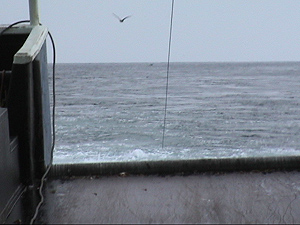Resource Ecology & Ecosystem Modeling Program
AFSC Seabird Program
| |

Figure 2. View of third wire cable astern of catcher-processor vessel while net is being towed. |
The AFSC Seabird Program is working on several
projects including the study of seabird food availability through
discards and offal from the commercial fisheries. The program is working
with the Washington Sea Grant Program (WSGP) and the North Pacific
Groundfish Observer Program (NPGOP) in preparation for WSGP’s demersal
longline integrated weight studies in July through November 2005.
Seabird stationary sighting surveys were again implemented for the AFSC
summer groundfish survey charters, but were also expanded in 2005 to
include hydroacoustic surveys and cod pot research charters. This work
depends on many AFSC employees who staff these cruises to take extra
time to complete the surveys. Their work is critical to this effort.
Most work currently undertaken by the Seabird Program
focuses on seabird interactions with the trawl fleet. Seabirds are known
to sometimes collide with the main warp cables used for towing the net
or with the trawl sonar third wire cable used for monitoring net
performance and catch while towing. The rates of these interactions are
not known. No short-tailed albatross, an endangered species, have been
documented as interacting with this gear, but there is concern that this
might occur.
Efforts are under way to both develop deterrent devices and
better characterize the interaction rates. These efforts involve close
collaboration with the trawl industry, WSGP, and the University of
Washington. We are coordinating with the Pollock Conservation
Cooperative (PCC) and WSGP to develop seabird deterrent devices for
trawl catcher processor vessels. Funds to support materials and
installation have come from the NMFS National Cooperative Research
Program and from the PCC.
Gear was pilot tested on one vessel during the
Pollock A season January through April 2005 and will be fitted
for an additional vessel for the pollock B season, June through October
2005. With support from the U.S. Fish and Wildlife Service Ecological
Services Division and the NMFS Cooperative Research Program, funding was
provided to support a research team boarding these two vessels to
complete some experimental trials during late July and August. Ed Melvin
of WSGP is the principle investigator for that work.
In addition to developing mitigation devices, NMFS is
working to better characterize seabird bycatch on trawl vessels. A NPGOP
special project is ongoing throughout the 2005 season for all trawl
observers. Information derived from this project will allow us to better
understand seabird interactions with trawl warp and third wire cables by
fishery sector. Finally, we are working on meeting nondiscretionary
requirements under one of the two short-tailed albatross biological
opinions to provide reports on trawl effort and the use of trawl sonar
technology, and have implemented work with the UW to develop a
risk-assessment model for trawl fishery sectors on the likelihood of
interactions with short-tailed albatross.
Seabird Provisioning by Commercial Fisheries
|
|

Figure 3. Feather with three pieces clipped out for stable isotope analysis. Using stable isotope
analysis, samples collected from different sections of this Laysan Albatross flight feather will
be used to asses the bird’s diet at different times of year. Diet over a period of 7 weeks can be
sampled from a single feather, and diet over a 4-month period can be sampled from five flight feathers.
|
The impact of commercial fishing on food availability
for seabirds through discards and offal is being explored on two fronts
by Dr. Ann Edwards, a National Research Council postdoctoral fellow with
the REFM Division’s REEM Program. The diets of Laysan and black-footed
albatrosses are being compared across seasons, between age classes, and
before and after the presence of large-scale fishing operations in the
North Pacific (pre-1930s vs. the present). Comparisons are made using
the stable isotopic signatures of feather samples obtained from birds
salvaged from longlines and from museum specimens (Fig. 2). As part of
this study, research cruises in the North Pacific and Bering Sea are
collecting samples for isotopic analysis of 1) the albatrosses’ natural
prey, squid, and 2) the most abundant species made available to seabirds
by the Alaska groundfish fishery, such as walleye pollock and Pacific
cod.
Progress continues towards developing a quantifiable
map in space and time of discards and offal returned to the sea, and
thus made available to seabirds and the marine ecosystem as a whole.
Data from the NMFS Alaska Regional Office’s Catch Accounting System on
retained and discarded catch provide the foundation for this map. John
Hansen, a graduate student at the UW School of Marine Affairs is working
with Dr. Edwards to review federal regulations mandating fish retention
and utilization standards. The goal of this review is to more accurately
track the fate of all parts of all fish pulled on board fishing vessels.
This review as well as consultations with industry may suggest
adjustments to the Catch Accounting System data to more accurately
reflect a birds’ eye view of food availability.
By Shannon Fitzgerald and Ann Edwards
>>>continued
 |

|
Quarterly sidebar
AFSC Quarterly Research Reports April-June 2005
Contents
Feature
ABL Reports
NMML Reports
RACE Reports
REFM Reports
Items
Quarterly Index
Quarterly Home
|

